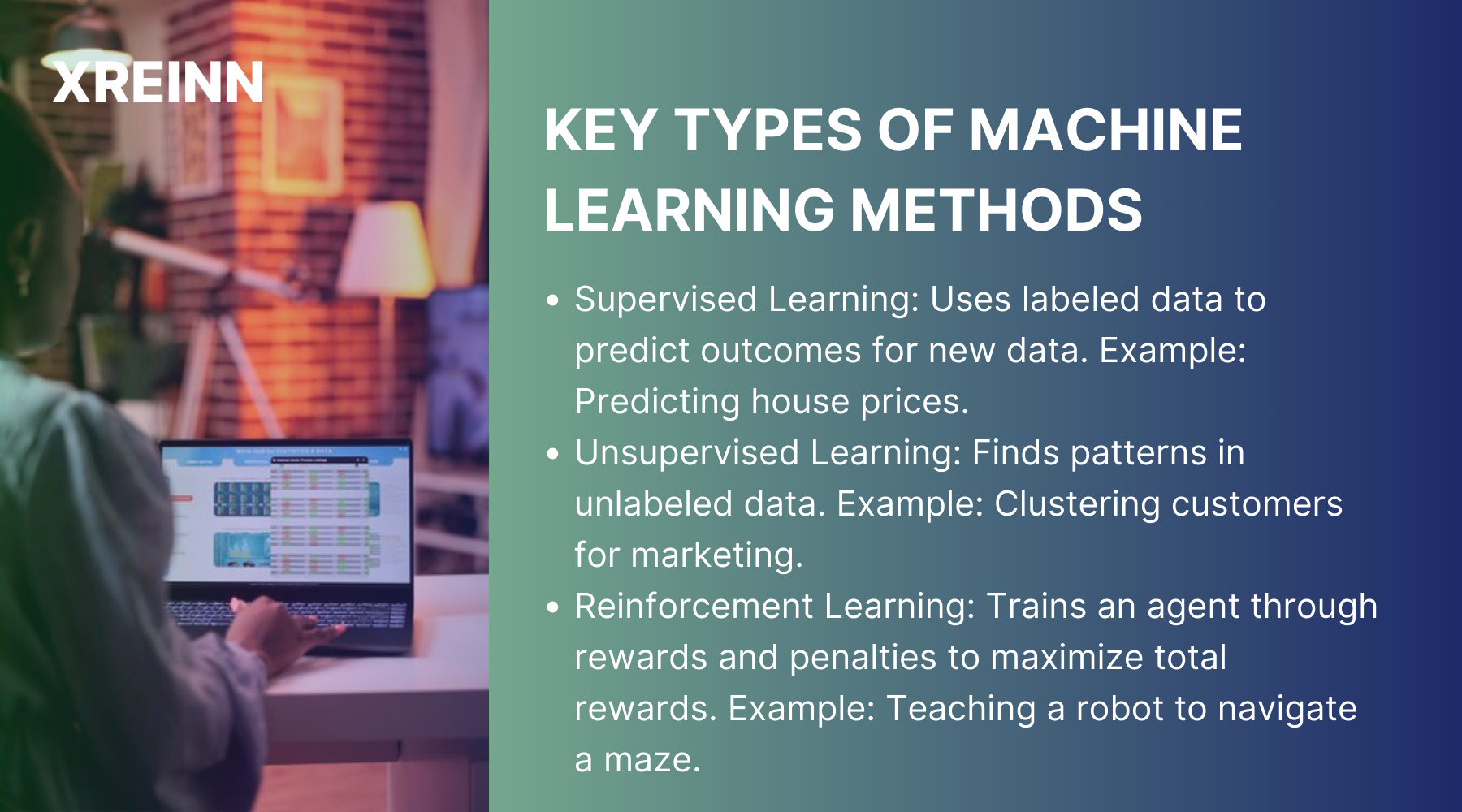Data Analytics
Fundamentals of Machine Learning For Predictive Data Analytics
Jul 02, 2024
In today's data-driven world, machine learning has become a very important factor in predictive data analytics. Whether you are predicting customer behavior, financial trends, or healthcare outcomes, machine learning provides the tools to make accurate and insightful predictions. Let’s explore the fundamentals of machine learning for predictive data analytics, covering key concepts, methods, and applications.
What is Machine Learning?
Machine learning is a subset of artificial intelligence (AI) that focuses on building systems that can learn from and make decisions based on data. Unlike traditional programming, where a developer writes explicit instructions for the computer to follow, machine learning involves training models on data so they can make predictions or decisions without being explicitly programmed to perform the task.
Types of Machine Learning

There are three main types of machine learning: supervised learning, unsupervised learning, and reinforcement learning. Each type has different applications and is used for different kinds of problems.
Supervised Learning
In supervised learning, the model is trained on a dataset that includes both input data and the correct output. Think of it like a teacher giving a student both the questions and the answers. The goal is for the model to learn the relationship between the inputs and the outputs so it can predict the output for new, unseen inputs.
For example, if you want to predict house prices, you might have a dataset with various features of the house (like size, number of bedrooms, location) and the corresponding price. The model learns from this data and can then predict the price of a new house based on its features.
Unsupervised Learning
Unsupervised learning involves training a model on data without labeled responses. Here, the model tries to find patterns and relationships in the data on its own. It's like giving the student only the questions and asking them to figure out the answers.
One common application of unsupervised learning is clustering. For instance, a company might use clustering to group customers with similar purchasing behaviors. This can help you in marketing strategies, such as creating targeted campaigns for different customer segments.
Reinforcement Learning
Reinforcement learning is a bit different from the other two types. It involves training an agent to make a sequence of decisions by rewarding it for good decisions and punishing it for bad ones. Over time, the agent learns to maximize the total reward.
Imagine training a robot to navigate a maze. The robot receives a reward for reaching the end of the maze and penalties for hitting walls. Through trial and error, it learns the best path to take to reach the goal.
Key Concepts in Machine Learning
Data Preprocessing
Before feeding data into a machine learning model, it needs to be cleaned and prepared. This step is called data preprocessing. It involves handling missing values, converting categorical data into numerical form, and normalizing the data.
For example, if you're working with a dataset that has some missing values, you might choose to fill those gaps with the mean value of the column or remove the rows with missing values altogether.
Model Training and Evaluation
Training a model involves feeding it data and allowing it to learn the patterns. Once trained, the model needs to be evaluated to see how well it performs on new data. This is done using a separate test dataset that wasn't used during training. Common metrics for evaluation include accuracy for classification tasks and mean squared error (MSE) for regression tasks.
Overfitting and Underfitting
Overfitting happens when a model learns the training data too well, including the noise and outliers. This results in poor performance on new data. Underfitting occurs when a model is too simple to capture the underlying patterns in the data, leading to poor performance on both training and test data.
To prevent overfitting, techniques like cross-validation (splitting the data into multiple parts and training the model on each part) and regularization (adding a penalty for larger coefficients in linear models) are used.
Common Machine Learning Algorithms
Linear Regression
Linear regression is a simple yet powerful algorithm used for predicting a continuous target variable. It assumes a linear relationship between the input features and the target variable. The goal is to find the line (or hyperplane in higher dimensions) that best fits the data.
For example, in predicting house prices, linear regression might use features such as the number of bedrooms, square footage, and location to predict the price.
Logistic Regression
Logistic regression is used for binary classification problems, where the target variable has two possible outcomes (e.g., yes/no, spam/ham). Despite its name, logistic regression is a linear model that estimates the probability of a binary outcome using the logistic function.
For instance, logistic regression can be used to predict whether an email is spam or not based on features like the presence of certain keywords and the sender's email address.
Decision Trees
Decision trees are versatile models used for both classification and regression tasks. They work by splitting the data into subsets based on the value of input features, creating a tree-like structure of decisions.
For example, a decision tree might be used to predict whether a customer will buy a product based on features like age, income, and browsing behavior.
Random Forests
Random forests are an ensemble method that combines multiple decision trees to improve performance and reduce overfitting. Each tree in the forest is trained on a random subset of the data and features, and the final prediction is made by averaging the predictions of all trees (for regression) or taking a majority vote (for classification).
For instance, a random forest can be used to predict credit card fraud by combining the predictions of multiple decision trees, each trained on different subsets of transaction data.
Support Vector Machines (SVM)
Support vector machines are powerful models used for classification and regression tasks. They work by finding the hyperplane that best separates the data into classes, with a maximum margin between the classes.
For example, SVMs can be used to classify images of handwritten digits based on pixel intensity values.
Neural Networks
Neural networks are a class of models inspired by the human brain's structure and function. They consist of layers of interconnected neurons, with each neuron performing a simple computation. Neural networks are particularly effective for tasks involving complex patterns, such as image and speech recognition.
For instance, neural networks can be used to identify objects in images, transcribe spoken language into text, and translate languages.
Applications of Machine Learning in Predictive Data Analytics
Healthcare
In healthcare, machine learning predicts patient outcomes, diagnoses diseases and personalizes treatment plans. For example, predictive models can analyze patient data to identify those at risk of developing chronic conditions, allowing for early intervention and preventive care.
Finance
In finance, machine learning is used for credit scoring, fraud detection, and algorithmic trading. Predictive models can assess an individual's creditworthiness based on their financial history, detect fraudulent transactions in real time, and optimize trading strategies based on market data.
Marketing
In marketing, machine learning is used to predict customer behavior, segment markets, and personalize marketing campaigns. For example, predictive models can analyze customer purchase history to identify potential churners and recommend personalized offers to retain them.
Retail
In retail, machine learning is used for demand forecasting, inventory management, and recommendation systems. Predictive models can forecast product demand based on historical sales data, optimize inventory levels to reduce stockouts and overstock, and recommend products to customers based on their browsing and purchase history.
Manufacturing
In manufacturing, machine learning is used for predictive maintenance, quality control, and supply chain optimization. Predictive models can analyze sensor data from machinery to predict failures and schedule maintenance before breakdowns occur, monitor product quality in real-time to detect defects and optimize supply chain operations to reduce costs and improve efficiency.
Transportation
In transportation, machine learning is used for traffic prediction, route optimization, and autonomous vehicles. Predictive models can analyze traffic data to predict congestion and suggest alternative routes, optimize delivery routes for logistics companies, and enable self-driving cars to navigate safely and efficiently.
Challenges and Future Directions
Data Quality and Quantity
One of the biggest challenges in machine learning is ensuring the quality and quantity of data. High-quality data is essential for training accurate models, but real-world data is often messy, incomplete, and biased. Collecting and preprocessing data can be time-consuming and expensive, especially for large datasets.
Model Interpretability
Another challenge is model interpretability. Some machine learning models, such as neural networks, are often considered "black boxes" because their inner workings are not easily understood by humans. This can be problematic in fields like healthcare and finance, where understanding the reasoning behind predictions is crucial for trust and accountability.
Ethical and Legal Considerations
Machine learning also raises ethical and legal considerations, such as bias and fairness, privacy, and accountability. Models trained on biased data can perpetuate and amplify existing biases, leading to unfair and discriminatory outcomes. Ensuring the privacy and security of sensitive data is another important concern, as is determining who is responsible for the decisions made by machine learning models.
Advancements in Machine Learning
Despite these challenges, machine learning continues to advance rapidly. New techniques and algorithms are being developed to improve model accuracy, interpretability, and fairness. For example, explainable AI (XAI) aims to make machine learning models more transparent and understandable, while federated learning allows models to be trained on decentralized data without compromising privacy.
Integration with Other Technologies
Machine learning is also increasingly being integrated with other technologies, such as the Internet of Things (IoT), blockchain, and edge computing. IoT devices generate vast amounts of data that can be analyzed using machine learning to gain insights and optimize operations. Blockchain provides a secure and transparent way to store and share data, while edge computing allows machine learning models to be deployed closer to the data source, reducing latency and improving efficiency.
Conclusion
Machine learning is transforming predictive data analytics, enabling more accurate and insightful predictions across a wide range of applications. By understanding the fundamentals of machine learning, including key concepts, common algorithms, and practical applications, organizations can harness the power of data to drive innovation and improve decision-making. While challenges remain, ongoing advancements in machine learning and related technologies promise to unlock new possibilities and opportunities for predictive data analytics.

Data Analytics
Jun 27, 2024Master key concepts in data analytics with practical tips to enhance decision-making and achieve success in your projects and professional growth

Data Analytics
Jul 01, 2024Learn the essential stages of the data analytics workflow to turn your data into valuable business insights and drive growth.

